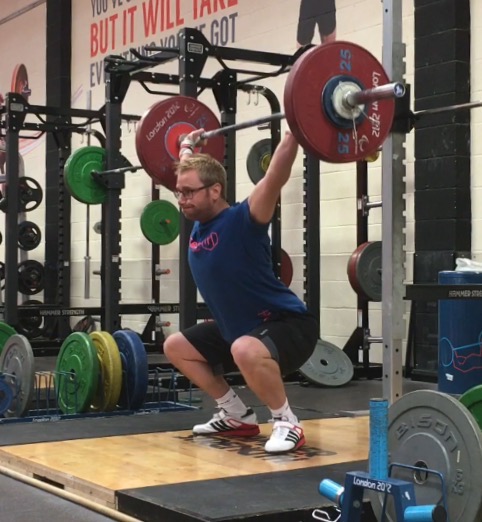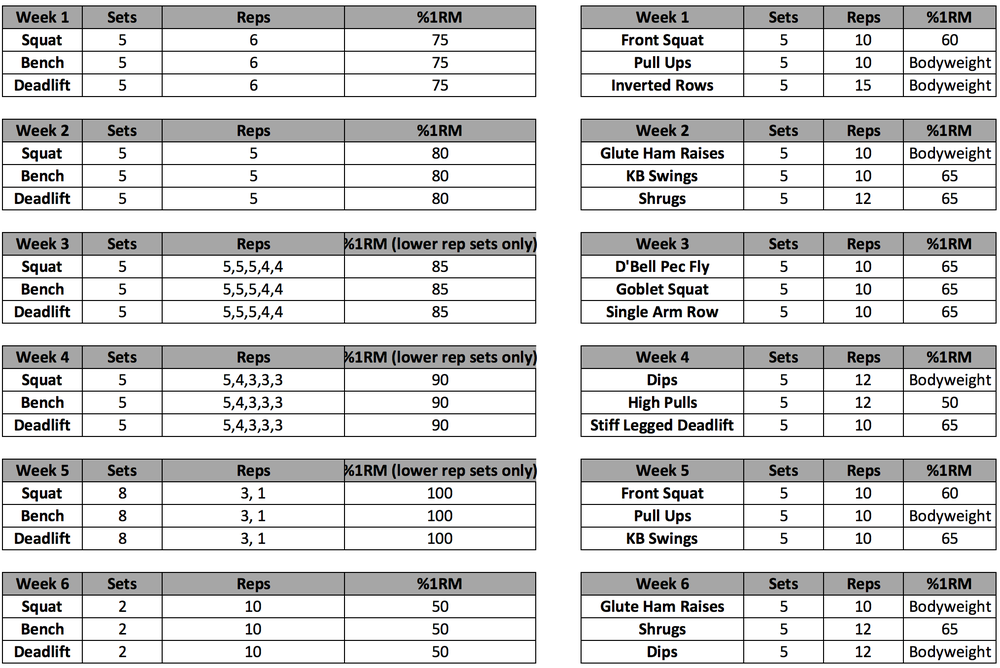Strength Training Programme Fundamentals
Strength Training Programme Fundamentals
This is the third and final part of my summer strength training series. Here are links to Part 1: Effective Strength Building Strategies and Part 2: How to Avoid Injury Whilst Strength Training. The three articles teach you real-world techniques to improve your strength. These are techniques that I personally use in my own training and have used to great effect with my personal training clients.
Now, on to article 3 – strength training programme fundamentals…
A strength training programme has essentially one goal – make the person stronger. Aesthetics in this case are a distant second.
A good strength training programme is to the point. There’s no fluff, no vanity exercises, just the biggest bang-for-your-buck exercises there are, supplemented with just enough accessory work – enough to keep you healthy and improve strength, without reducing recovery time too much.
In this strength training programme fundamentals article, I’ll explain a little of the science and anecdotal observations you need to be aware of when you design your own strength training programme.
Appropriate Rest Periods – Long or Short?
As we discussed in part 1 of this series, strength improvement is partly neural in its origin – improving your strength is as much to do with adaptions in your nervous system as it is your muscular make up. The other important element of strength improvement is hormonally driven – the rise in growth hormone as a result of the resistance exercise triggers the physiological changes that result in increased muscle size and strength.
There is a debate that hasn’t yet been conclusively settled in sports science about whether short or longer rest periods are better and why. Each side has solid evidence and logic to support their stance…
The longer recovery supporters point to evidence that shows phosphate (molecular compounds used during muscle contraction) levels recover fully over a 3-5 minute period, allowing a lifter to lift heavier weights more often, resulting in improved strength.
The shorter recovery supporters point to research that shows shorter rest periods typically force growth hormone levels higher during the workout. Higher levels of growth hormone result in more muscle growth (as long as the lifter refuels and recovers properly). More muscle growth leads to more strength.
My thoughts?
I like to use both.
With lighter prep sets I’ll keep my rest periods to 30-90 seconds. When I’m going heavier, I’ll leave a 2-3 minute recovery gap between sets.
There’s a couple of reasons I only leave a 2-3 minute recovery gap – the first is I have a decent training history under my belt. My body is used to training and can cope with the higher loads and intensity.
The second reason I only leave a 2-3 min gap is down to logistics – I don’t have the time to train for 3 hours! Who does?
If you aren’t interested in body composition at all, then I can see a way where you could afford to allow longer rests between sets of an exercise. For most lifters though the shorter rest periods in the lighter weights, with longer rests at heavier weights is a good approach.
Cleaner Exercise Selection – Fewer Exercises, More Strength.
Traditionally, strength sports are tested on a small amount of challenges. Weightlifting is a competition of two lifts: the snatch and the clean and jerk. Powerlifting is a competition of three lifts – the squat, bench press and deadlift. It makes for very streamlined programming.
When you consider the stress placed on the nervous system during a heavy strength training programme, you have to ensure you allow sufficient recovery for the lifter.
Trying to improve strength across too many exercises in a single programme is beyond the recovery capabilities of almost everyone, so if you want to see significant strength improvements across a programme, focus on a small number of lifts. There’s a reason Weight Lifting and Power Lifting only have 2 and 3 lifts each.
The bulk of the work in a strength training programme will focus on the competition lifts, with the rest of the session containing accessory and rehabilitation exercises. This is to prevent injury and overuse issues, but at the same time the accessory exercises also help to improve strength.
For competitive lifters, the competition lifts will be broken down further so the athletes can focus on improving both technique and strength simultaneously. For that reason their programming will look slightly different.
Pick the exercises you want to improve. Lets say Squat, Bench and Deadlift. Stick to those. I’ve given you a programme at the bottom on the article to help you improve those three lifts.
Make Steady, Regular Strength Progressions
Unless you are a complete beginner when it comes to strength training (or you’ve been training with a terrible programme), you’re unlikely to make massive leaps in strength beyond the first few months. Instead, focus more on steady, regular improvements – improvements that your body can cope with. It’s not cool to be injured all the time, regardless of what the old, beaten-up power lifters say.
Start with a light weight and add weight to the bar each week. What’s important here is adding weight, not reps – we’re programming for strength, not endurance (besides, endurance is largely strength repeated over and over). Our single metric of improvement is your 1 rep max (1RM) relative to your starting 1RM. If your 1RM is going up, what you are doing is working.
For the purposes of this article, we’ll focus on the non-competitive lifter who just wants to improve his strength. There’s a sample programme at the bottom of the article – it’s a real programme that I’ve used with clients and it has proven successful, so you guys can have it for free, because I’m a nice guy.
Strength Training Programme Starting Point
First, establish a starting point. The legendary strength coach Jim Wendler suggests lifters start from 65% to 70% of their 1RM. There isn’t an exact since to establishing your 1RM, but here’s how I do it…
Warm up thoroughly, then take a weight you can complete 10 good reps with. Add 50% to it. For example…
If you Deadlift 100kg for 10 reps, try 150kg. You’ll probably hit around 3 reps. According to Wendler, that’s usually 90% of your 1RM. If you can only do 3 reps, great. If you can do more, add more weight until you can only do 3 good reps. Once you have that figure, add 10% – that will be pretty close to your 1 rep max.
So, lets assume 150kg is 90% of your 1RM. Add an extra 10% – in this case, 15kg, making your assumed 1RM 165kg.
In the strength training programme I’ve included in this article, you’ll have to perform this exercise for each of the three lifts in the programme – squat, bench press and deadlift. If you already know your 1RM or even your 3RM, you’ll be able to do it instantly.
Sample Strength Programme
I have added a sample strength programme into the article, to give you an idea of how you should be training. All of the points mentioned in the posts this series are covered.
You’ll notice there are two programmes. The one on the right is the accessory work. Do this twice per week and the Squat/Bench/Deadlift programme once per week. Doing more strength work won’t improve your strength quicker – your strength improves when you let your body recover.
Strength Training Programme Tips…
- Calculate your 1RM at the start of the programme. Use that figure as your basis for the rest of the training cycle. If on week 5 (where you lift your 1RM) it’s too light, add more weight to the bar until you are lifting your new 1RM.
- Rest periods – rest for 90 seconds between sets. If you are lifting 3RM or heavier, rest for 2-3 minutes between sets.
- Conditioning. I’d suggest you add in a fourth workout per week, but that should be conditioning based. If you need ideas, check this and this out.
- Warm up. Start with a 500m row, mobility work and then 2 sets of 15 reps of each exercise with an empty bar. Only when you’ve warmed up should you train. If you want more guidance with warm ups, look at article 2 in this series.
The Strength Training Programme
Final Strength Training Observations
I’ve said before that my biggest strength-training weakness is my impatience. I want to be making regular improvements and am frustrated with the time it often takes. I should know better, but logic and emotion don’t always work in sync and it occasionally gets the better of me!
Despite this, I’ve made large strides over the years. I certainly don’t have Herculean strength, but I’m not an embarrassment either. As it stands, my PB’s at a bodyweight of 85-90kg (depending on my training cycle) look like this…
Bench press: 125kg
Back Squat: 160kg
Deadlift: 190kg
Snatch Grip Deadlift: 140kg
Front Squat: 150kg
Overhead Squat: 70kg
Military Press: 67kg
Clean: 108kg
Clean and Jerk: 90kg
Snatch: 75kg
Despite these, I remember the days when a 60kg deadlift was a struggle. A 40kg bench press was pushing my limits. I remember going to the gym and wondering whether or not a 50kg squat was pushing my luck.
I started Olympic lifting properly in March this year. I was struggling with a 60kg clean – now it’s my warm up.
My point? You can and will improve your strength, if you apply the principles I’ve discussed in this article series, you’ll see your strength improve too. These are the very same principles of strength improvement that I use in both my own training and my personal training clients programmes.
I’ve mentioned before – using the right kit is important. Here are the four bits of kit I don’t train without…
I hope you’ve learned a few things from this strength training series and I’d love you to share some of your results from this series with me!
The links to parts 1 and 2 are here…



